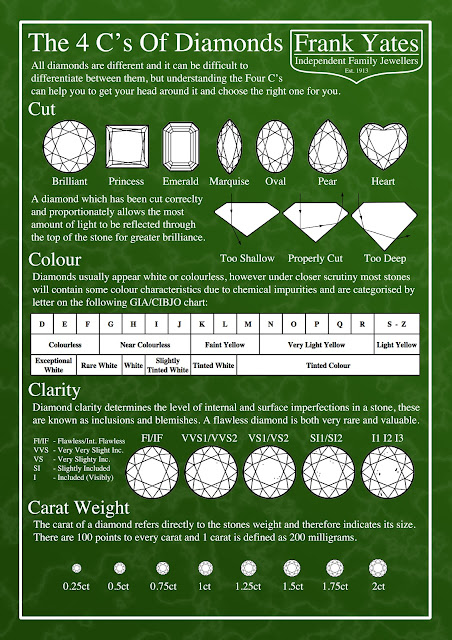Buying a diamond can be really quite a daunting task for many people, and for good reason, as it is a substantial investment for something that is inherently small. Choosing the right diamond is important as it will be with you for a very long time, because as they say A Diamond Is Forever. But it doesn’t have to be stressful and can be an enjoyable process, as for many people buying their first diamond it is a symbol of love. There are four main factors to consider which will influence both the appearance and the price of a diamond, these are known as the Four C’s, Cut, Colour, Clarity and Carat Weight. While these guidelines allow some theory to be applied when buying a piece of diamond jewellery, it is important not to get too caught up with grades and numbers. A diamond is a visual piece so it needs to look perfect too.
Cut
The cut of a diamond directly relates to the proportions and arrangement of it’s facets. Modern cuts typically have 58 facets which, when cut to the correct proportions, allow for the greatest amount of light to be reflected and dispersed through the top of the stone. Light will be lost through the side or the bottom of the stone if it is cut too shallow or too deeply. Popular terms for describing the light-handling qualities of a diamond are reflection, dispersion, scintillation and fire. Choosing the shape of a diamond is something that is completely dependent on personal preference, with the brilliant cut being the most popular. Other popular shapes include the princess, emerald, marquise, oval, pear and heart shaped. There are other fancy cuts, with some brands and designers releasing patented diamond cuts.
Colour
Diamonds usually appear white or colourless, however under closer scrutiny most stones will contain some colour characteristics. This is determined by any chemical impurities and defects in the crystal structure. A perfect diamond is completely colourless and also incredibly rare and valuable. Diamonds which possess an intense pure colour are also very rare and valuable. Coloured diamonds can be found in in blue, yellow, pink, orange, green and red, with red being the rarest.
Clarity
Diamond clarity determines the level of internal and surface imperfections in a stone, these are known as inclusions and blemishes. Most grades of inclusions are not visible to the naked eye and don’t have a real negative affect on the light reflection and dispersal of the diamond, often referred to as nature’s fingerprints.
Carat Weight
The carat of a diamond refers directly to the stones weight and therefore also indicates its size. There are 100 points to every carat, meaning that a 75 point diamond is equal to three quarters of a carat. Diamonds were originally weighed against the seeds of the carob tree, or the Greek keration meaning ‘fruit of the carob’, until the unit was standardised and one carat was defined as equal to 200 milligrams. Generally the larger the diamond the more rare and valuable it is, however two stones of equal size can have incredibly different values depending on the other three C’s, cut, colour and clarity.
